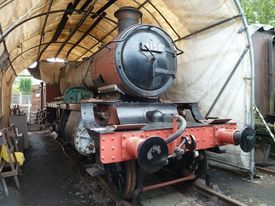GWR Large Prairie 4150
| GWR Large Prairie 4150 | |
|---|---|
 4150 in course of restoration at Bewdley | |
| Built By | GWR Swindon Works |
| Configuration | 2-6-2T |
| Power class | 4MT |
| Status | Under restoration |
| Loco Number | 4150 |
| History | |
| Built | 1947 |
| Designed By | Charles Collett |
| Type | GWR 5101 |
| 1974 | Purchased by The 4150 Fund |
| 1978 | Arrived on SVR |
| Technical | |
| Length | 41ft |
| Weight | 78t 15cwt |
4150 is a GWR 5101 class 2-6-2T locomotive, commonly referred to as a Large Prairie.
Contents
4150 in service
‘Large prairie’ tanks were a common sight on the GWR, with more than 300 built between 1903 and 1949 to the same basic design. The locomotives were designed to haul semi-fast and suburban passenger services to tight schedules, and were also used on medium distance freight services. A number of Large Prairies were allocated to Kidderminster and Shrewsbury sheds and were regularly used on the Severn Valley Railway in its declining years.
The 5101 Class was an updated version by CB Collett of Churchward's 1903 3100/5100 Class. Fellow class member GWR Large Prairie 5164 is an early 1930 example, while 4150 is a later post-War example. The 41xx number arose from the GWR practice, where more than 100 locomotives of one class were built, of maintaining the second number in the series and re-using older sequences of numbers where necessary. The prevalence of the Large Prairie also resulted in examples numbered 61xx, 31xx and 81xx.[1]
4150 was built at Swindon and entered service in June 1947. The first allocation was to nearby Stourbridge Junction shed (84F) where the locomotive would have worked local services towards Birmingham.
In November 1948 it was involved in an accident at Lapworth station. While running round its train bunker first, it was struck by another train which had overrun a signal at danger in thick fog.[2] 4150 returned to traffic 45 days later, after repair at Swindon. The front buffer plank of 4150 is stamped "9006" and, as Dukedog 9006 was withdrawn for scrap shortly before this incident, it seems likely that parts of the older locomotive were used in the repair of 4150.[3]
1953 to 1962 was spent in the West Country, mainly at Newton Abbot. The final allocation was to Severn Tunnel Junction where 4150, by then in run down condition, was used to bank heavy trains through the tunnel. The locomotive was withdrawn from service by BR in June 1965 after 18 years in service and sent to Barry Scrapyard.
Gallery
4150 in preservation
4150 was purchased at a cost of £2,750 from Barry in 1973 by The 4150 Fund. No 4150 left Barry in 1974 in company with No.7812 Erlestoke Manor, and was towed by a Class 25 diesel to Parkend on the Dean Forest Railway.
Restoration at Parkend proved impossible, and in 1977 the Fund’s shareholders voted to move 4150 to the SVR, with the locomotive arriving at Bewdley on 19 January 1978.
Restoration commenced following arrival in Bewdley Yard, but by the mid-80s fund raising and restoration progress had slowed considerably. In 2007 the Fund formed a new committee, and with renewed enthusiasm began a concerted effort to complete the restoration which had by then been in progress for more than 30 years. By 2014 a new bunker had been completed except for riveting and welding, and construction of new tanks was in progress. As of November 2016[update], riveting of the side tanks is ongoing, and it is intended that the locomotive will be moved to Bridgnorth for continuation of the overhaul in early 2017.[4][5]
Gallery
See also
References
- ↑ [http://www.greatwestern.org.uk/m_in_262.htm Great Western Archive
- ↑ Newspaper cuttings on www.rowingtonrecords.com
- ↑ The 4150 Fund Newsletter, 2016
- ↑ SVR Live - 4150 - Prairie Tank, Ex GWR
- ↑ The 4150 Fund - September 2016 Restoration Update
SVR News
Severn Valley Railway Stock Book, seventh edition.
4150 Fund web site
Links
4150 Fund web site Retrieved 26 February 2015
GWR 5101 Class on Wikipedia






